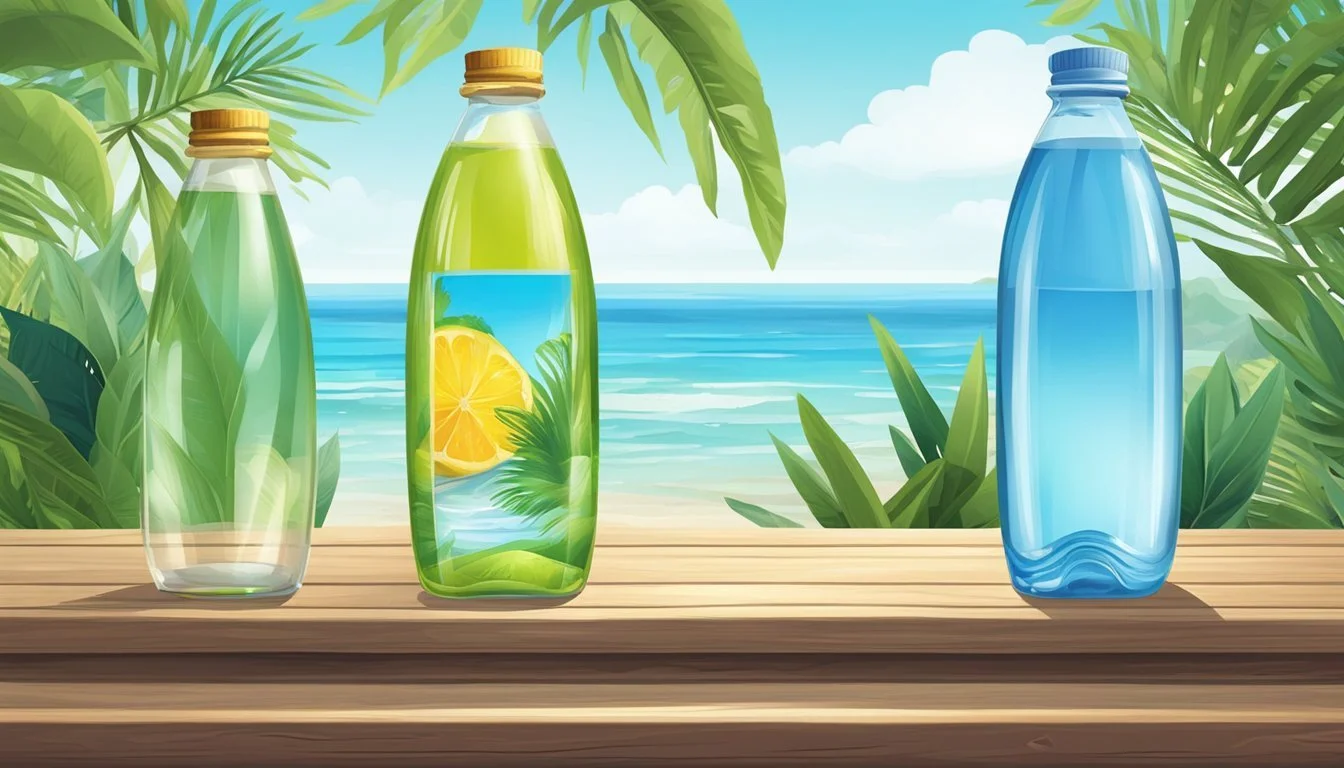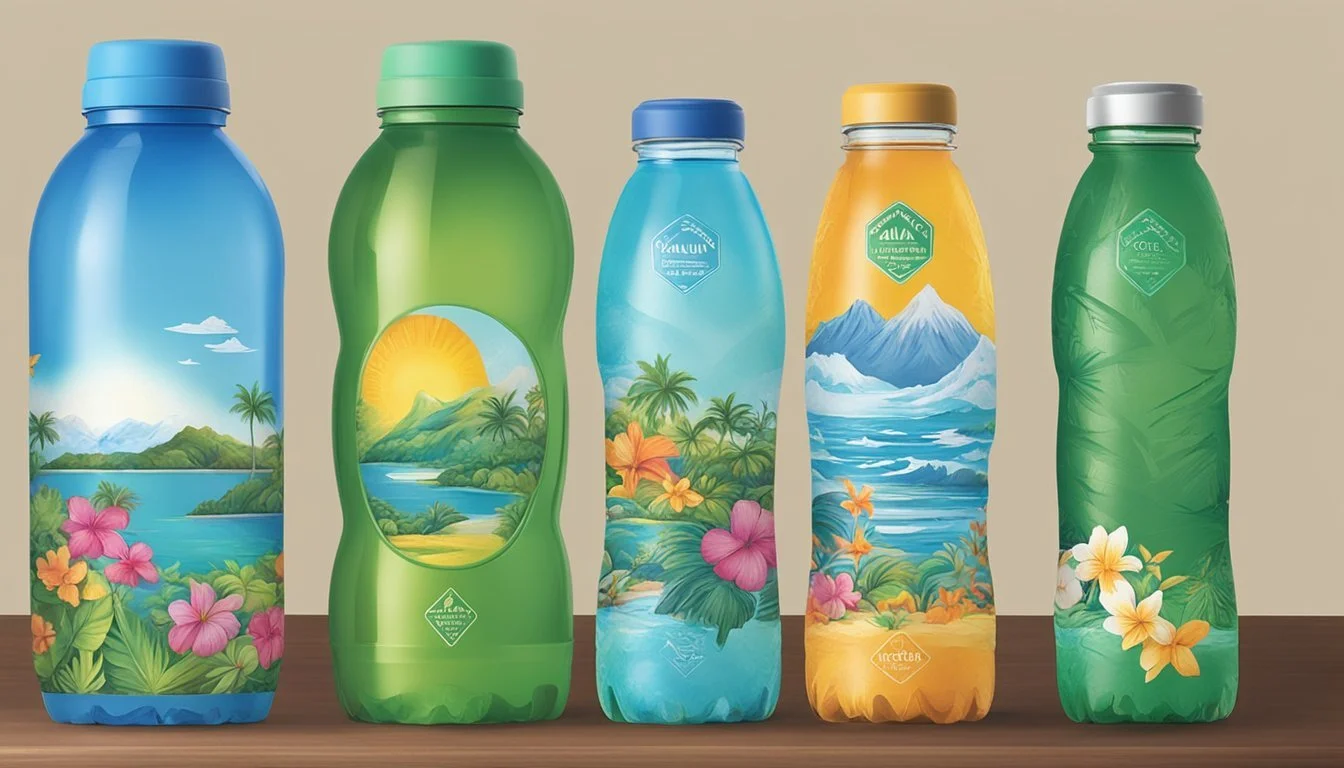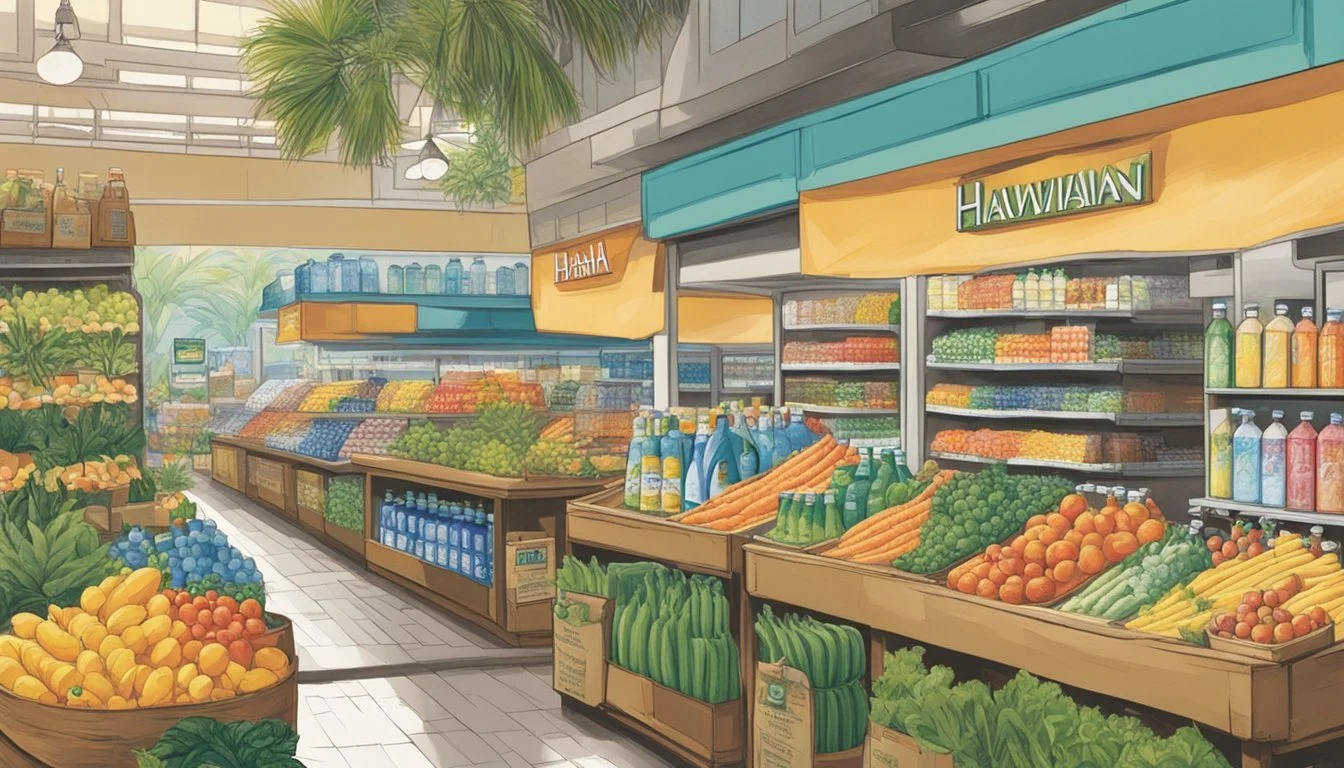Hawaiian Springs vs. Big Chill
An Expert Comparison of Bottled Waters
When it comes to choosing the best bottled water, consumers are often faced with a myriad of options. Among the popular choices are Hawaiian Springs and Big Chill, each offering unique qualities that appeal to different preferences. Hawaiian Springs is renowned for its pure, natural taste, sourced from the Big Island's aquifers, making it a favorite among those who prioritize clean and mineral-rich water.
Big Chill, distributed by CVS Pharmacy, stands out for its accessibility and neutral flavor profile. This purified water is rigorously tested to ensure quality and safety, appealing to consumers who prefer a straightforward and dependable option. For those seeking a blend of purity and reliability, Hawaiian Springs might edge out Big Chill with its unique island source and taste.
Both brands serve their purpose well, catering to diverse customer needs. While Hawaiian Springs may attract those looking for premium, naturally sourced water, Big Chill offers a convenient, consistently neutral alternative. Readers can explore the detailed comparisons throughout the post to decide which aligns best with their preferences.
Understanding Bottled Water
Different brands and types of bottled water vary greatly in their sources, health benefits, and environmental impact. Each of these aspects influences the choices consumers make when selecting bottled water.
Source and Types
Bottled water comes from various sources including natural springs, artesian wells, and municipal sources. Hawaiian Springs prides itself on sourcing from artesian aquifers in Hawaii, whereas Big Chill often uses purified water from municipal sources that undergo reverse osmosis treatment.
The types of bottled water include spring water, purified water, distilled water, and alkaline water. Spring water emerges from underground sources, while purified water has been filtered to remove contaminants. Alkaline water, known for its higher pH, and distilled water, which is boiled and recondensed to remove impurities, each offer different benefits.
Health Implications
The health benefits of bottled water depend significantly on its mineral content and purification process. Natural spring and artesian waters, like Hawaiian Springs, contain essential minerals such as calcium and magnesium, which can be beneficial for health. In contrast, brands like Big Chill that use purified water through reverse osmosis may add minerals back for taste and health benefits.
Alkaline water is believed by some to help balance pH levels in the body, though scientific evidence on this is mixed. Electrolyte-infused waters can aid in hydration, especially after intense physical activities. Importantly, all reputable bottled waters are tested for safety, ensuring they are free from harmful contaminants.
Environmental Impact
The environmental impact of bottled water is a significant consideration for many consumers. Hawaiian Springs and Big Chill need to address concerns over the sustainability of their source and the ecological footprint of their production and distribution processes.
Bottling and transporting water can have a high carbon footprint. Sustainable practices, like using recyclable packaging and sourcing water responsibly, are vital. Additionally, choosing local brands can reduce the environmental impact associated with long-distance shipping.
The plastic waste generated from bottled water can be a substantial environmental challenge. Brands that prioritize environmentally friendly packaging and support recycling programs contribute positively to reducing this impact.
Brand Overviews
The two brands, Hawaiian Springs and Big Chill, stand out for their unique features and origins, offering consumers varied choices in the realm of bottled water.
Hawaiian Springs
Hawaiian Springs is famous for its unique source and pristine quality. Originating from the island of Hawaii, this water is sourced from aquifers deep beneath Mauna Loa. The natural filtration through volcanic rock imparts a distinct mineral profile and taste.
Hawaiian Springs strives for sustainability and leverages eco-friendly packaging made from 100% recycled materials. It markets itself as a premium product, often compared to other high-end brands like Fiji Water and Voss.
Key Points:
Origin: Hawaii (Mauna Loa)
Packaging: 100% recycled materials
Competitors: Fiji Water, Voss
Big Chill
Big Chill is known for its affordability and accessibility, often found in major retail stores. While not marketed as a premium brand, it is a popular choice for those seeking reliable hydration without breaking the bank.
Its source and filtration process are less conspicuous compared to Hawaiian Springs, focusing more on mass production and consistent quality. Unlike boutique brands such as Icelandic Glacial, Big Chill aims to cater to everyday consumers.
Key Points:
Focus: Affordability and availability
Market: Everyday consumers
Competitors: Dasani, Aquafina
These overviews highlight the fundamental differences and key features of Hawaiian Springs and Big Chill, providing a clear picture of what each brand offers to their distinct consumer bases.
Taste and Quality Analysis
In examining Hawaiian Springs and Big Chill, it’s crucial to assess their flavor profiles and the levels of purity and cleanliness. These factors will help determine which water offers a superior drinking experience.
Flavor Profile
Hawaiian Springs offers a crisp and refreshing taste. The natural minerals contribute to a balanced flavor with no aftertaste. It has a slightly alkaline pH level, typically around 7.7, which can enhance its smoothness. This water is ideal for those who prefer a clean, light taste without any chemical hints.
Big Chill, on the other hand, is known for its neutral taste, free from metallic or plastic flavors. It often contains electrolytes added for taste, which can provide a slight but pleasant tang. This characteristic makes it a popular choice among those seeking an everyday hydration option.
Purity and Cleanliness
Hawaiian Springs undergoes minimal processing to retain its natural purity. Sourced from aquifers deep within Mauna Loa, it’s filtered for impurities but keeps beneficial minerals. This bottling process ensures the water remains free of contaminants, offering a pristine drinking experience.
Big Chill utilizes a multi-step purification process, including reverse osmosis and UV light treatment, to ensure high purity levels. This method effectively removes any potential contaminants, resulting in water that is exceptionally clean. It is devoid of sodium and artificial preservatives, making it a safe choice for daily consumption.
By focusing on these core elements of taste and quality, one can make an informed decision between Hawaiian Springs and Big Chill.
Packaging and Sustainability
In comparing Hawaiian Springs and Big Chill, key factors include the design and materials used for their bottles, as well as their environmental initiatives. Both companies emphasize sustainability, but their approaches vary.
Bottle Design and Materials
Hawaiian Springs uses PET plastic for its bottles, which are lightweight and recyclable. Their bottle design features a sleek, modern aesthetic that appeals to consumers looking for premium bottled water. However, PET plastic, while recyclable, often ends up in landfills due to inefficient recycling practices.
Big Chill opts for boxed water packaging, made mostly of paper from FSC-certified forests, with smaller amounts of bio-plastic and aluminum. This makes their packaging 92% renewable, the highest plant-based content among sustainable water brands. The design is minimalist, focusing on functionality and environmental impact.
Environmental Initiatives
Hawaiian Springs engages in initiatives that promote recycling and reduce plastic waste. They partner with various organizations to support cleaning up oceans and waterways. Their commitment is reflected in campaigns aimed at educating consumers about the importance of recycling PET bottles.
Big Chill takes a broader approach by reducing carbon footprint through renewable packaging. They emphasize eco-friendly production processes and aim to lower the environmental impact of their operations. Big Chill also collaborates with conservation groups to protect ecosystems and invest in reforestation projects. Their initiatives are designed to create long-term sustainability.
Consumer Experience and Accessibility
Hawaiian Springs and Big Chill offer varied experiences in terms of availability, distribution, and pricing, significantly influencing the consumer's choice and accessibility.
Availability and Distribution
Hawaiian Springs is prominently available in many retail stores across Hawaii and select mainland regions. Its distribution strategy leverages both local stores and major supermarket chains, although it can be somewhat limited in areas outside Hawaii. This brand is also accessible through online retailers, expanding its reach to mainland consumers.
Big Chill, on the other hand, has a broader distribution network. It is widely available in numerous states, both in convenience stores and large retail chains. In addition, it is sold at competitive prices in vending machines and supermarkets, making it readily accessible for most consumers. This brand's strong online presence ensures that even those in remote areas can easily purchase their products.
Price Point
Hawaiian Springs often positions itself in the premium bottled water market. The pricing reflects its origin, sourced from the aquifers of Hawaii, and adds a sense of exclusivity. Consumers may find Hawaiian Springs priced higher compared to other bottled water brands, which can be a consideration for those looking for more cost-effective options.
Big Chill is generally found at a more accessible price point. This brand typically offers competitive pricing that appeals to a wider consumer base, making it an attractive option for those looking for quality water without the premium cost. The affordability and widespread availability of Big Chill make it a preferable choice for many everyday consumers.
In summary, while Hawaiian Springs offers a premium product with more limited distribution, Big Chill provides a more widely accessible and cost-effective option for consumers.
Health and Wellness Perspective
Examining the health benefits and potential drawbacks of Hawaiian Springs and Big Chill, focusing on hydration and key minerals, can help make an informed choice between these two brands.
Hydration and Benefits
Hawaiian Springs water is naturally alkaline with a pH level of around 7.7. This can help balance acidity in the body.
Alkaline water is known for its potential anti-aging and detoxifying properties.
The presence of essential minerals like calcium, magnesium, and potassium contribute to better hydration.
Electrolytes in Hawaiian Springs support nerve function and muscle health.
Big Chill, sourced from purified municipal water, also provides basic hydration needed for daily health.
This brand may not possess the natural mineral content found in Hawaiian Springs.
While it effectively hydrates, it lacks added health benefits from electrolytes and minerals.
However, Big Chill offers a more cost-effective solution for maintaining general hydration.
Comparative Health Analysis
When comparing the mineral content, Hawaiian Springs contains higher levels of natural minerals.
Calcium and magnesium in Hawaiian Springs support bone health and cardiovascular function.
Potassium helps regulate fluid balance and prevents muscle cramps.
Big Chill's purification process removes most minerals. It is similar to other purified water brands like Essentia and LIFEWTR.
While it is safe and free from contaminants, it may not provide the additional health benefits associated with natural mineral water.
For those looking for enhanced hydration and additional health benefits, Hawaiian Springs is a preferable choice.
Hawaiian Springs is also known for its eco-friendly bottling practices, using sustainable materials.
Big Chill, on the other hand, often relies on standard plastic bottles which may contain minimal amounts of plastic derivatives.
In terms of health advantages, Hawaiian Springs stands out for its natural minerals and alkaline properties, offering more comprehensive benefits beyond basic hydration compared to Big Chill.
Market Presence and Brand Reputation
Hawaiian Springs and Big Chill are two prominent water brands with distinct market positions and reputations. Each brand has cultivated consumer loyalty through different strategies and perceptions shaped by their marketing messages.
Consumer Loyalty and Feedback
Hawaiian Springs enjoys a loyal customer base, often highlighted by its distinctive product quality and the exotic appeal of its Hawaiian origin. Consumers frequently praise the water's taste and purity, leading to positive reviews on various platforms.
Big Chill, on the other hand, garners appreciation for its cost-effectiveness and wide availability. Though it may not have the same exotic allure, it nonetheless holds a strong presence in mass markets and is often favored for its reliable quality and affordability.
Both brands cater to different market demographics, with Hawaiian Springs appealing to those seeking premium, unique bottled water, and Big Chill attracting value-conscious customers. The brands' strategic placement in stores and online availability contribute significantly to their market presence.
Brand Messaging and Perception
Hawaiian Springs emphasizes its source from the Hawaiian islands, leveraging the pristine, natural image of Hawaii in its marketing. The brand positions itself as a premium product with an emphasis on purity and environmental responsibility, resonating particularly well with eco-conscious consumers.
Big Chill’s brand messaging centers around reliability and affordability. It is commonly marketed in a straightforward manner, highlighting its accessibility and consistent quality. This pragmatic approach makes Big Chill a go-to choice for everyday hydration needs, appealing to a broad consumer base.
Hawaiian Springs and Big Chill utilize distinct branding strategies to solidify their market positions, targeting different segments through tailored messaging. Hawaiian Springs taps into its exotic appeal and sustainability, while Big Chill focuses on cost-efficiency and ubiquity, ensuring wide market reach.
Conclusion and Recommendations
When comparing Hawaiian Springs and Big Chill bottled water, several factors stand out.
Hawaiian Springs is bottled directly at the source from renewable aquifers. It has a naturally alkaline pH of 7.7+ and comes in fully recyclable containers. This combination offers a thoughtful balance of taste and sustainability for the consumer.
Big Chill focuses on purity and reliability. It boasts a clean taste without the plastic aftertaste often found in other brands. Being a popular choice, it maintains a strong consumer preference for those prioritizing flavor and consistency.
Criteria Hawaiian Springs Big Chill Source Renewable aquifers Various purified sources pH Level Alkaline (7.7+) Neutral Packaging Fully recyclable Standard plastic bottles Taste Balanced with minerals Pure without plastic taste Consumer Choice High High
Different consumers may value distinct features. Those who prioritize eco-friendly practices and balanced mineral content might favor Hawaiian Springs. On the other hand, Big Chill may be preferred for its taste purity and reliability.
Best Water determination depends on what the consumer values most, whether it's ecological impact, taste, or purity.
Path to choosing the right bottled water includes understanding each brand's offerings and weighing them against personal preferences. Both Hawaiian Springs and Big Chill have their merits and cater to various consumer needs.
In Castle Rock areas where natural water sources are valued, Hawaiian Springs might appeal more due to its natural sourcing. However, urban settings might see a preference for readily available and pure options like Big Chill.
More About Hawaiian Springs
Acqua Pana vs Hawaiian Springs: Which Bottled Water is Better?
Aqua Carpatica vs Hawaiian Springs: Which Bottled Water is Better?
Aquafina vs Hawaiian Springs: Which Bottled Water is Better?
Arrowhead vs Hawaiian Springs: Which Bottled Water is Better?
Boxed Water vs Hawaiian Springs: Which Bottled Water is Better?
Castle Rock vs Hawaiian Springs: Which Bottled Water is Better?
Core Hydration vs Hawaiian Springs: Which Bottled Water is Better?
Deer Park vs Hawaiian Springs: Which Bottled Water is Better?
Essentia vs Hawaiian Springs: Which Bottled Water is Better?
Hawaiian Springs vs 1907water: Which Bottled Water is Better?
Hawaiian Springs vs 7-Select: Which Bottled Water is Better?
Hawaiian Springs vs Alkaline88: Which Bottled Water is Better?
Hawaiian Springs vs Antipodes: Which Bottled Water is Better?
Hawaiian Springs vs BodyArmor: Which Bottled Water is Better?
Hawaiian Springs vs Cascade Mountain: Which Bottled Water is Better?
Hawaiian Springs vs CBD Living: Which Bottled Water is Better?
Hawaiian Springs vs Crystal Geyser: Which Bottled Water is Better?
Hawaiian Springs vs Crystal Lake: Which Bottled Water is Better?
Hawaiian Springs vs Essence pH10: Which Bottled Water is Better?
Hawaiian Springs vs Hawaii Volcanic: Which Bottled Water is Better?
Hawaiian Springs vs Kirkland Signature: Which Bottled Water is Better?
Hawaiian Springs vs Liquid Death: Which Bottled Water is Better?
Hawaiian Springs vs Mananalu: Which Bottled Water is Better?
Hawaiian Springs vs Open Water: Which Bottled Water is Better?
Hawaiian Springs vs Proud Source: Which Bottled Water is Better?
Hawaiian Springs vs Pure Life: Which Bottled Water is Better?
Hawaiian Springs vs Purely Sedona: Which Bottled Water is Better?
Hawaiian Springs vs Refreshe: Which Bottled Water is Better?
Hawaiian Springs vs Richard's Rainwater: Which Bottled Water is Better?
Hawaiian Springs vs Simple Truth: Which Bottled Water is Better?
Hawaiian Springs vs Solan de Cabras: Which Bottled Water is Better?
Hawaiian Springs vs Talking Rain AQA: Which Bottled Water is Better?
Hawaiian Springs vs The Well: Which Bottled Water is Better?
Hawaiian Springs vs Tru Alka: Which Bottled Water is Better?
Hawaiian Springs vs Weird Water: Which Bottled Water is Better?
Hawaiian Springs vs Whole Foods 365: Which Bottled Water is Better?
Hawaiian Springs vs Whole Foods Italian Still Mineral water: Which Bottled Water is Better?
Ice Mountain vs Hawaiian Springs: Which Bottled Water is Better?
Icelandic Glacial vs Hawaiian Springs: Which Bottled Water is Better?
Just Water vs Hawaiian Springs: Which Bottled Water is Better?
Mountain Valley Spring Water vs Hawaiian Springs: Which Bottled Water is Better?
Nestle Pure Life vs Hawaiian Springs: Which Bottled Water is Better?
Poland Spring vs Hawaiian Springs: Which Bottled Water is Better?
San Pellegrino vs Hawaiian Springs: Which Bottled Water is Better?
Smartwater vs Hawaiian Springs: Which Bottled Water is Better?
Topo Chico vs Hawaiian Springs: Which Bottled Water is Better?
Zephyrhills vs Hawaiian Springs: Which Bottled Water is Better?
More About Big Chill
Big Chill vs Kirkland Signature: Which Bottled Water is Better?
Big Chill vs Talking Rain AQA: Which Bottled Water is Better?
Big Chill vs Whole Foods 365: Which Bottled Water is Better?
Cascade Mountain vs Big Chill: Which Bottled Water is Better?
Hawaii Volcanic vs Big Chill: Which Bottled Water is Better?
Icelandic Glacial vs Big Chill: Which Bottled Water is Better?
Mountain Valley Spring Water vs Big Chill: Which Bottled Water is Better?
Nestle Pure Life vs Big Chill: Which Bottled Water is Better?
Richard's Rainwater vs Big Chill: Which Bottled Water is Better?
Solan de Cabras vs Big Chill: Which Bottled Water is Better?
Whole Foods Italian Still Mineral water vs Big Chill: Which Bottled Water is Better?









